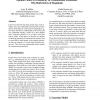253 search results - page 2 / 51 » When More Alternatives Lead to Less Choice |
86
Voted
IJIS
2006
15 years 11 days ago
2006
It has been observed that when people make crude estimates, they feel comfortable choosing between alternatives which differ by a half-order of magnitude (e.g., were there 100, 30...
EICS
2010
ACM
15 years 5 months ago
2010
ACM
In Human Computer Interaction, plasticity refers to the capacity of User Interfaces (UIs) to withstand variations of context of use while preserving quality in use. Frequently, in...
69
Voted
COGSCI
2010
15 years 14 days ago
2010
We created paired moral dilemmas with minimal contrasts in wording, a research strategy that has been advocated as a way to empirically establish principles operative in a domain-...
WADS
1989
Springer
15 years 4 months ago
1989
Springer
rees can be used for representing abstract data types such as dictionaries and ordered lists. They work well when the elements are inserted in a random order. Some sequences of ope...
93
Voted
EURODAC
1995
IEEE
15 years 3 months ago
1995
IEEE
Iterative improvement partitioning algorithms such as the FM algorithm of Fiduccia and Mattheyses 8 , the algorithm of Krishnamurthy 13 , and Sanchis's extensions of these al...

